Abstract
BACKGROUND--Several recent studies have reported associations between short term changes in air pollution and respiratory hospital admissions. This relationship was examined in two cities with substantially different levels of sulphur dioxide (SO2) but similar levels of airborne particles in an attempt to separate the effects of the two pollutants. Significant differences in weather between the two cities allowed the evaluation of that potential confounder also. METHODS--Daily counts of admissions to all hospitals for respiratory disease (ICD 9 460-519) were constructed for persons aged 65 years and older in two cities - New Haven, Connecticut and Tacoma, Washington. Each city was analysed separately. Average daily concentrations of SO2, inhalable particles (PM10), and ozone were computed from all monitors in each city, and daily average temperature and humidity were obtained from the US weather service. Daily respiratory admission counts were regressed on temperature, humidity, day of the week indicators, and air pollution. A 19 day weighted moving regression filter was used to remove all seasonal and subseasonal patterns from the data. Possible U-shaped dependence of admissions on temperature was dealt with using indicator variables for eight categories each of temperature and humidity. Each pollutant was first examined individually and then multiple pollutant models were fitted. RESULTS--All three pollutants were associated with respiratory hospital admissions of the elderly. The PM10 associations were little changed by control for either ozone or SO2. The ozone association was likewise independent of the other pollutants. The SO2 association was substantially attenuated by control for ozone in both cities, and by control for PM10 in Tacoma. The magnitude of the effect was small (relative risk 1.06 in New Haven and 1.10 in Tacoma for a 50 micrograms/m3 increase in PM10, for example) but, given the ubiquitous exposure, this has some public health significance. CONCLUSIONS--Air pollution concentrations within current guidelines were associated with increased respiratory hospital admissions of the elderly. The strongest evidence for an independent association was for PM10, followed by ozone. These results are consistent with other studies and suggest that lowering air pollution concentrations would have some impact on public health.
Full text
PDF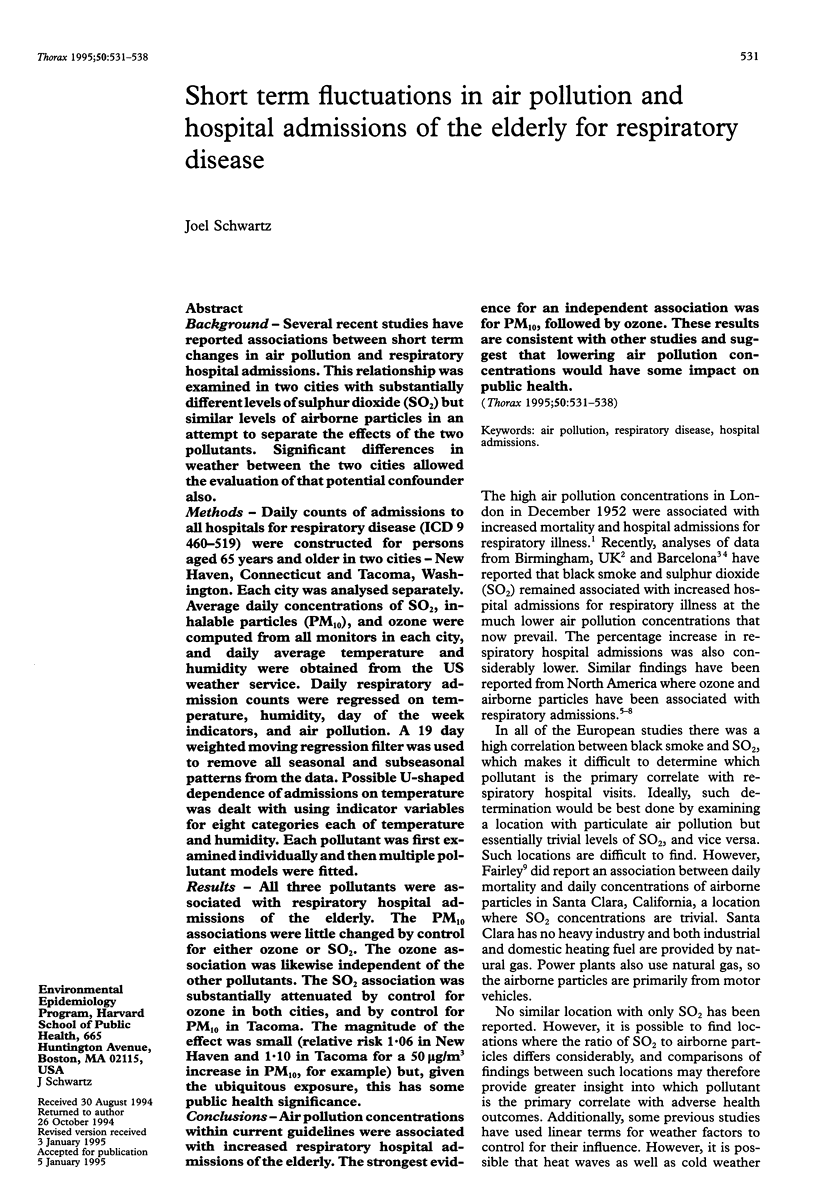
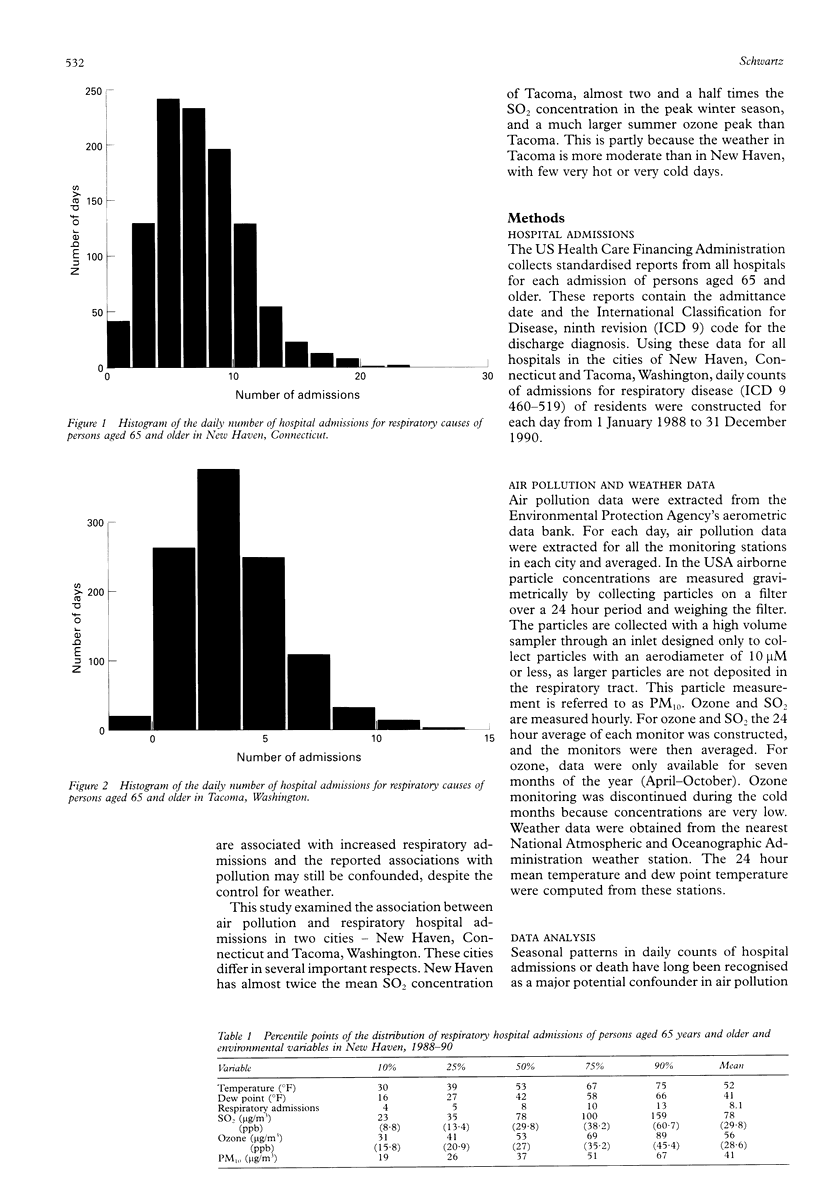
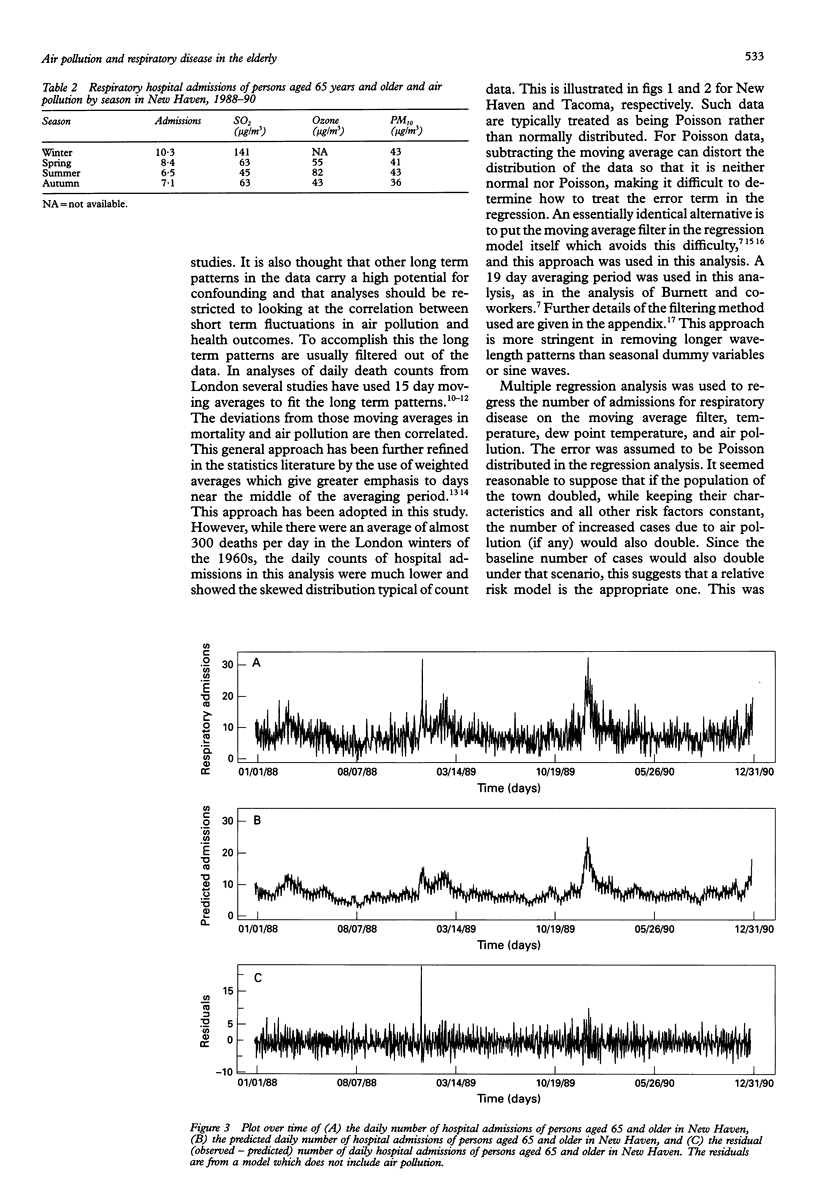
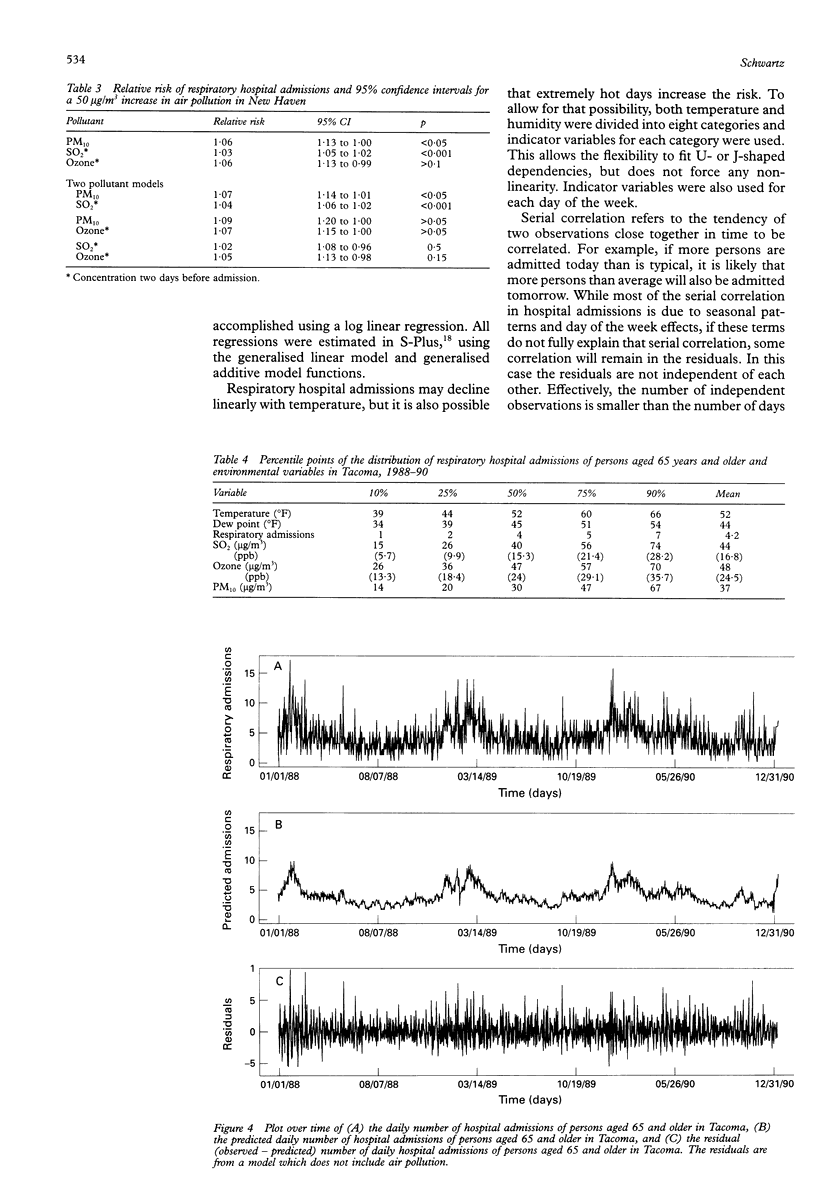
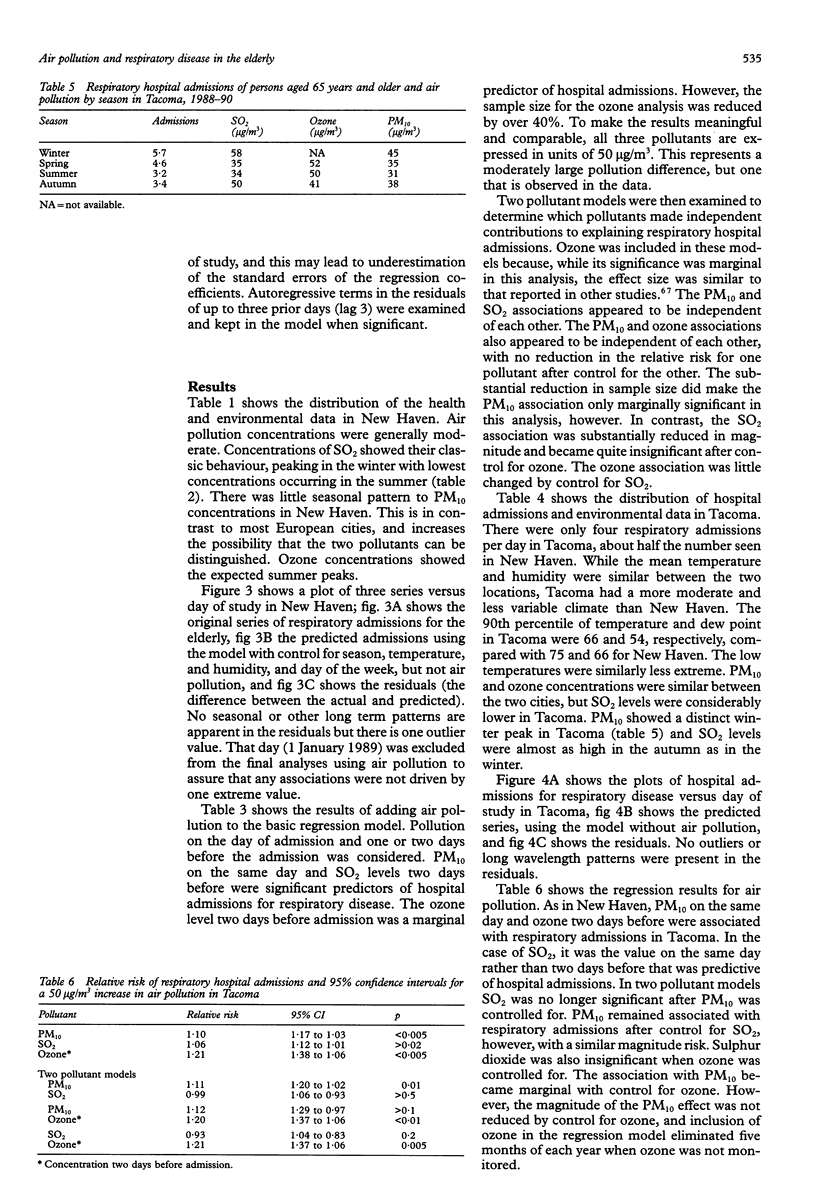
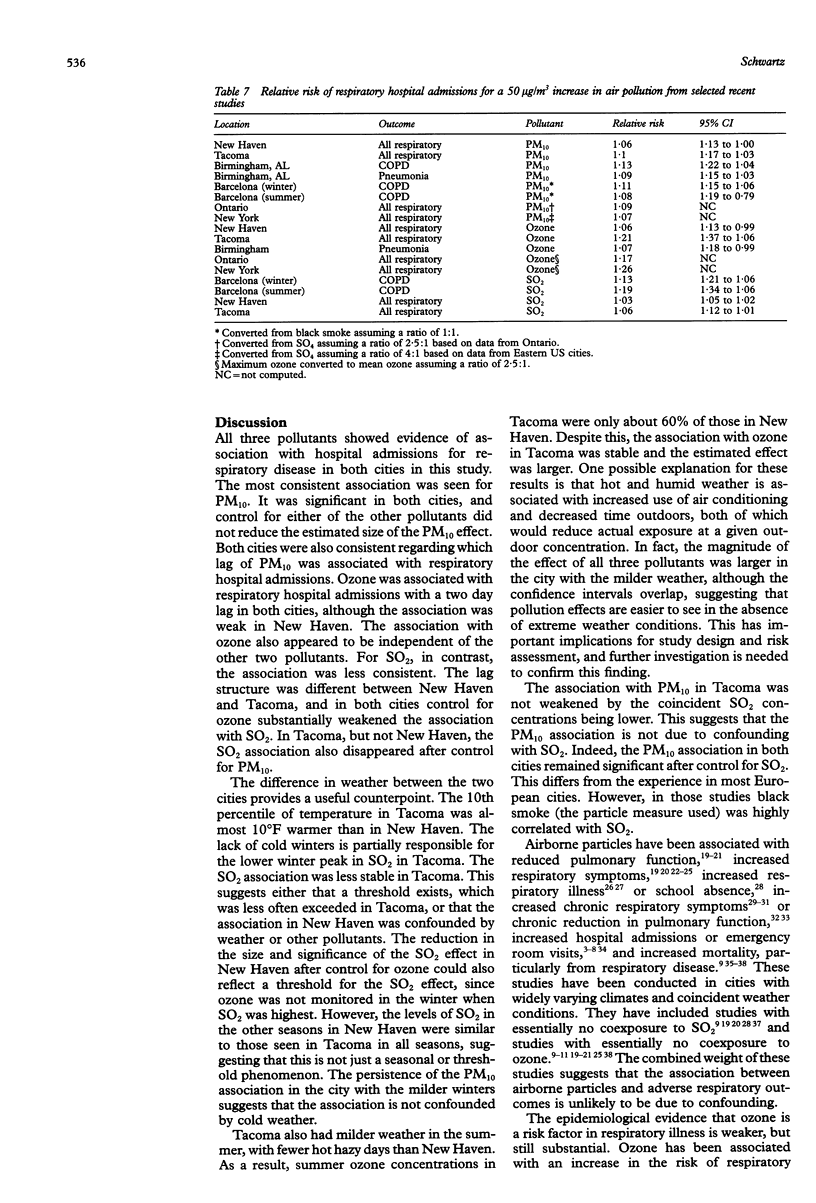
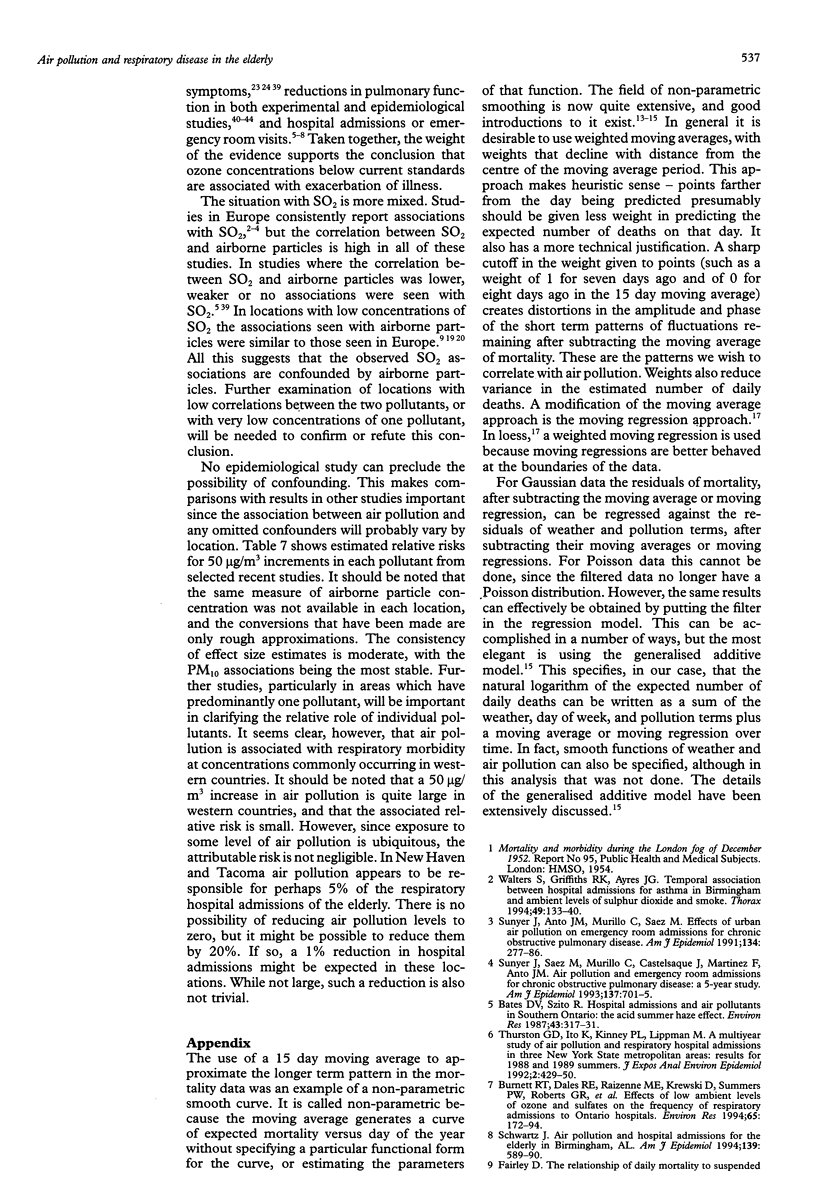
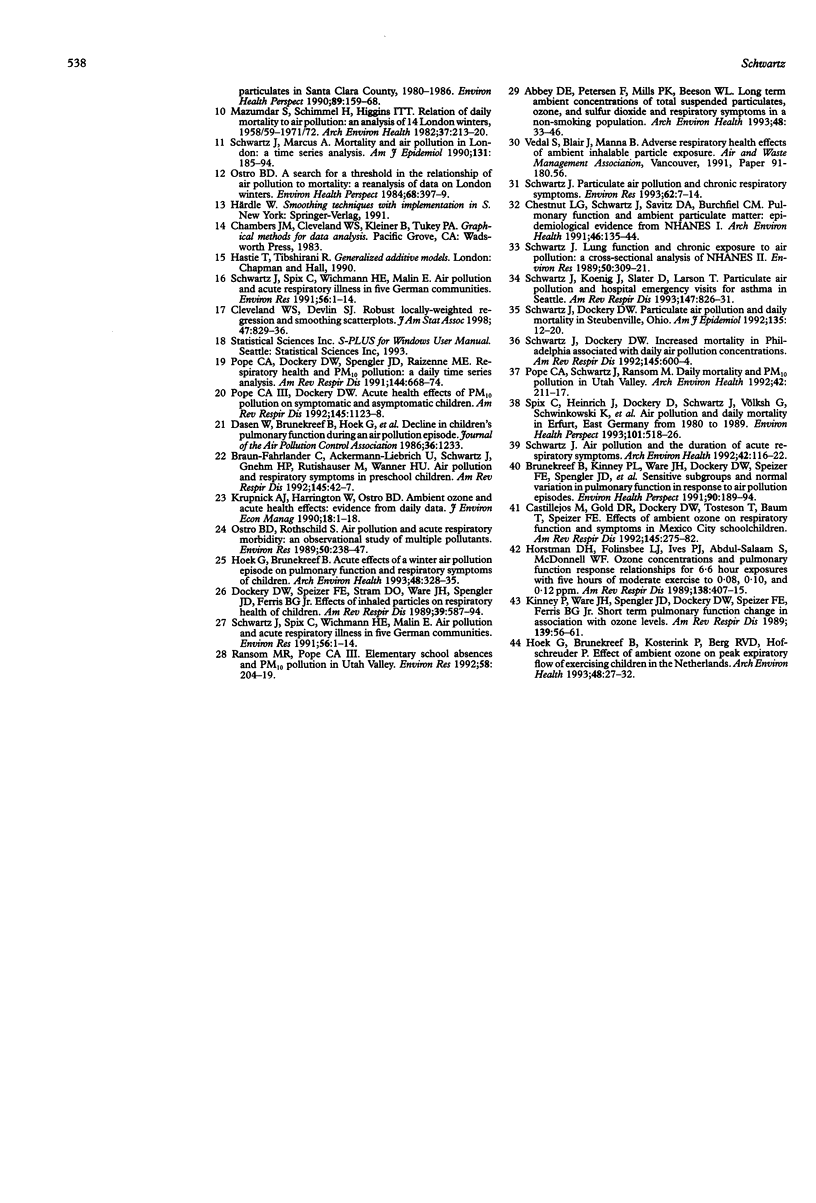
Selected References
These references are in PubMed. This may not be the complete list of references from this article.
- Abbey D. E., Petersen F., Mills P. K., Beeson W. L. Long-term ambient concentrations of total suspended particulates, ozone, and sulfur dioxide and respiratory symptoms in a nonsmoking population. Arch Environ Health. 1993 Jan-Feb;48(1):33–46. doi: 10.1080/00039896.1993.9938391. [DOI] [PubMed] [Google Scholar]
- Bates D. V., Sizto R. Air pollution and hospital admissions in Southern Ontario: the acid summer haze effect. Environ Res. 1987 Aug;43(2):317–331. doi: 10.1016/s0013-9351(87)80032-4. [DOI] [PubMed] [Google Scholar]
- Braun-Fahrländer C., Ackermann-Liebrich U., Schwartz J., Gnehm H. P., Rutishauser M., Wanner H. U. Air pollution and respiratory symptoms in preschool children. Am Rev Respir Dis. 1992 Jan;145(1):42–47. doi: 10.1164/ajrccm/145.1.42. [DOI] [PubMed] [Google Scholar]
- Brunekreef B., Kinney P. L., Ware J. H., Dockery D., Speizer F. E., Spengler J. D., Ferris B. G., Jr Sensitive subgroups and normal variation in pulmonary function response to air pollution episodes. Environ Health Perspect. 1991 Jan;90:189–193. doi: 10.1289/ehp.90-1519500. [DOI] [PMC free article] [PubMed] [Google Scholar]
- Burnett R. T., Dales R. E., Raizenne M. E., Krewski D., Summers P. W., Roberts G. R., Raad-Young M., Dann T., Brook J. Effects of low ambient levels of ozone and sulfates on the frequency of respiratory admissions to Ontario hospitals. Environ Res. 1994 May;65(2):172–194. doi: 10.1006/enrs.1994.1030. [DOI] [PubMed] [Google Scholar]
- Chestnut L. G., Schwartz J., Savitz D. A., Burchfiel C. M. Pulmonary function and ambient particulate matter: epidemiological evidence from NHANES I. Arch Environ Health. 1991 May-Jun;46(3):135–144. doi: 10.1080/00039896.1991.9937440. [DOI] [PubMed] [Google Scholar]
- Dockery D. W., Speizer F. E., Stram D. O., Ware J. H., Spengler J. D., Ferris B. G., Jr Effects of inhalable particles on respiratory health of children. Am Rev Respir Dis. 1989 Mar;139(3):587–594. doi: 10.1164/ajrccm/139.3.587. [DOI] [PubMed] [Google Scholar]
- Fairley D. The relationship of daily mortality to suspended particulates in Santa Clara County, 1980-1986. Environ Health Perspect. 1990 Nov;89:159–168. doi: 10.1289/ehp.9089159. [DOI] [PMC free article] [PubMed] [Google Scholar]
- Hoek G., Brunekreef B. Acute effects of a winter air pollution episode on pulmonary function and respiratory symptoms of children. Arch Environ Health. 1993 Sep-Oct;48(5):328–335. doi: 10.1080/00039896.1993.9936721. [DOI] [PubMed] [Google Scholar]
- Hoek G., Brunekreef B., Kosterink P., Van den Berg R., Hofschreuder P. Effect of ambient ozone on peak expiratory flow of exercising children in The Netherlands. Arch Environ Health. 1993 Jan-Feb;48(1):27–32. doi: 10.1080/00039896.1993.9938390. [DOI] [PubMed] [Google Scholar]
- Kinney P. L., Ware J. H., Spengler J. D., Dockery D. W., Speizer F. E., Ferris B. G., Jr Short-term pulmonary function change in association with ozone levels. Am Rev Respir Dis. 1989 Jan;139(1):56–61. doi: 10.1164/ajrccm/139.1.56. [DOI] [PubMed] [Google Scholar]
- Koren H. S., Devlin R. B., Graham D. E., Mann R., McGee M. P., Horstman D. H., Kozumbo W. J., Becker S., House D. E., McDonnell W. F. Ozone-induced inflammation in the lower airways of human subjects. Am Rev Respir Dis. 1989 Feb;139(2):407–415. doi: 10.1164/ajrccm/139.2.407. [DOI] [PubMed] [Google Scholar]
- Mazumdar S., Schimmel H., Higgins I. T. Relation of daily mortality to air pollution: an analysis of 14 London winters, 1958/59-1971/72. Arch Environ Health. 1982 Jul-Aug;37(4):213–220. doi: 10.1080/00039896.1982.10667567. [DOI] [PubMed] [Google Scholar]
- Ostro B. D., Rothschild S. Air pollution and acute respiratory morbidity: an observational study of multiple pollutants. Environ Res. 1989 Dec;50(2):238–247. doi: 10.1016/s0013-9351(89)80004-0. [DOI] [PubMed] [Google Scholar]
- Ostro B. A search for a threshold in the relationship of air pollution to mortality: a reanalysis of data on London winters. Environ Health Perspect. 1984 Dec;58:397–399. doi: 10.1289/ehp.8458397. [DOI] [PMC free article] [PubMed] [Google Scholar]
- Pope C. A., 3rd, Dockery D. W. Acute health effects of PM10 pollution on symptomatic and asymptomatic children. Am Rev Respir Dis. 1992 May;145(5):1123–1128. doi: 10.1164/ajrccm/145.5.1123. [DOI] [PubMed] [Google Scholar]
- Pope C. A., 3rd, Dockery D. W., Spengler J. D., Raizenne M. E. Respiratory health and PM10 pollution. A daily time series analysis. Am Rev Respir Dis. 1991 Sep;144(3 Pt 1):668–674. doi: 10.1164/ajrccm/144.3_Pt_1.668. [DOI] [PubMed] [Google Scholar]
- Pope C. A., 3rd, Schwartz J., Ransom M. R. Daily mortality and PM10 pollution in Utah Valley. Arch Environ Health. 1992 May-Jun;47(3):211–217. doi: 10.1080/00039896.1992.9938351. [DOI] [PubMed] [Google Scholar]
- Ransom M. R., Pope C. A., 3rd Elementary school absences and PM10 pollution in Utah Valley. Environ Res. 1992 Aug;58(2):204–219. doi: 10.1016/s0013-9351(05)80216-6. [DOI] [PubMed] [Google Scholar]
- Schwartz J. Air pollution and hospital admissions for the elderly in Birmingham, Alabama. Am J Epidemiol. 1994 Mar 15;139(6):589–598. doi: 10.1093/oxfordjournals.aje.a117048. [DOI] [PubMed] [Google Scholar]
- Schwartz J. Air pollution and the duration of acute respiratory symptoms. Arch Environ Health. 1992 Mar-Apr;47(2):116–122. doi: 10.1080/00039896.1992.10118764. [DOI] [PubMed] [Google Scholar]
- Schwartz J., Dockery D. W. Increased mortality in Philadelphia associated with daily air pollution concentrations. Am Rev Respir Dis. 1992 Mar;145(3):600–604. doi: 10.1164/ajrccm/145.3.600. [DOI] [PubMed] [Google Scholar]
- Schwartz J. Lung function and chronic exposure to air pollution: a cross-sectional analysis of NHANES II. Environ Res. 1989 Dec;50(2):309–321. doi: 10.1016/s0013-9351(89)80012-x. [DOI] [PubMed] [Google Scholar]
- Schwartz J., Marcus A. Mortality and air pollution in London: a time series analysis. Am J Epidemiol. 1990 Jan;131(1):185–194. doi: 10.1093/oxfordjournals.aje.a115473. [DOI] [PubMed] [Google Scholar]
- Schwartz J. Particulate air pollution and chronic respiratory disease. Environ Res. 1993 Jul;62(1):7–13. doi: 10.1006/enrs.1993.1083. [DOI] [PubMed] [Google Scholar]
- Schwartz J., Slater D., Larson T. V., Pierson W. E., Koenig J. Q. Particulate air pollution and hospital emergency room visits for asthma in Seattle. Am Rev Respir Dis. 1993 Apr;147(4):826–831. doi: 10.1164/ajrccm/147.4.826. [DOI] [PubMed] [Google Scholar]
- Schwartz J., Spix C., Wichmann H. E., Malin E. Air pollution and acute respiratory illness in five German communities. Environ Res. 1991 Oct;56(1):1–14. doi: 10.1016/s0013-9351(05)80104-5. [DOI] [PubMed] [Google Scholar]
- Schwartz J., Spix C., Wichmann H. E., Malin E. Air pollution and acute respiratory illness in five German communities. Environ Res. 1991 Oct;56(1):1–14. doi: 10.1016/s0013-9351(05)80104-5. [DOI] [PubMed] [Google Scholar]
- Spix C., Heinrich J., Dockery D., Schwartz J., Völksch G., Schwinkowski K., Cöllen C., Wichmann H. E. Air pollution and daily mortality in Erfurt, east Germany, 1980-1989. Environ Health Perspect. 1993 Nov;101(6):518–526. doi: 10.1289/ehp.93101518. [DOI] [PMC free article] [PubMed] [Google Scholar]
- Sunyer J., Antó J. M., Murillo C., Saez M. Effects of urban air pollution on emergency room admissions for chronic obstructive pulmonary disease. Am J Epidemiol. 1991 Aug 1;134(3):277–289. doi: 10.1093/oxfordjournals.aje.a116081. [DOI] [PubMed] [Google Scholar]
- Sunyer J., Sáez M., Murillo C., Castellsague J., Martínez F., Antó J. M. Air pollution and emergency room admissions for chronic obstructive pulmonary disease: a 5-year study. Am J Epidemiol. 1993 Apr 1;137(7):701–705. doi: 10.1093/oxfordjournals.aje.a116730. [DOI] [PubMed] [Google Scholar]
- Thurston G. D., Ito K., Kinney P. L., Lippmann M. A multi-year study of air pollution and respiratory hospital admissions in three New York State metropolitan areas: results for 1988 and 1989 summers. J Expo Anal Environ Epidemiol. 1992 Oct-Dec;2(4):429–450. [PubMed] [Google Scholar]
- Walters S., Griffiths R. K., Ayres J. G. Temporal association between hospital admissions for asthma in Birmingham and ambient levels of sulphur dioxide and smoke. Thorax. 1994 Feb;49(2):133–140. doi: 10.1136/thx.49.2.133. [DOI] [PMC free article] [PubMed] [Google Scholar]


